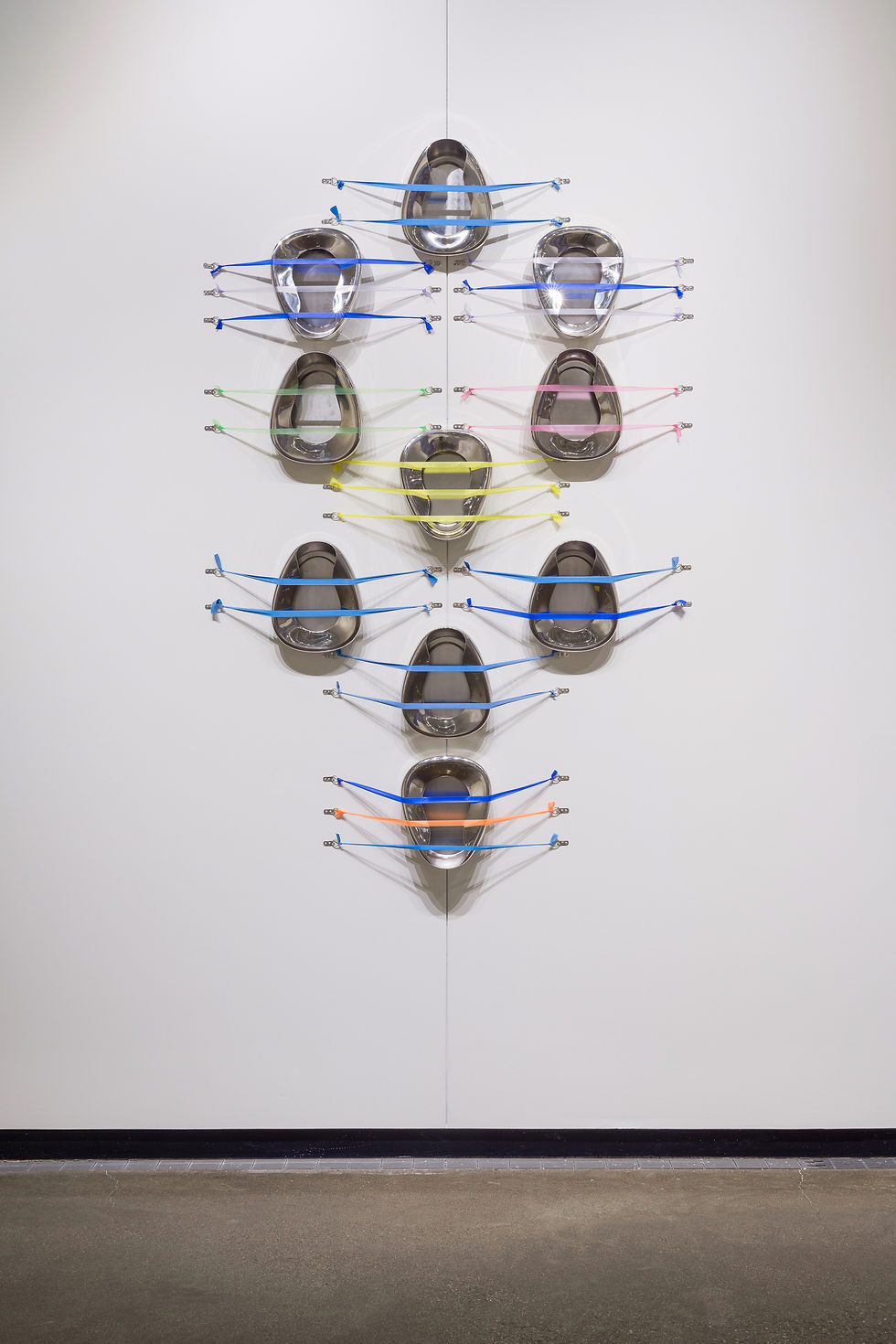Mae Howard / Rituals of suspension
- Bert Stabler
- Dec 20, 2023
- 6 min read
Updated: Jan 21, 2024

Bending Table, 2022
Plexi sheet, acrylic canes, stainless steel nails
38” x 61” x 36”
Amelia Jones writes that the chronically ill artist Bob Flanagan, most widely known for his masochistic performance work with his partner and top Sheree Rose, “constructed himself as both acting subject and receptive object of violence, merging subjectivity into objectivity for both Flanagan and his audience, and thus confusing the security of either identification.” Petra Kuppers expands on this theme, stating: “What can’t be experienced in the warding-off of uncertainty (about self, subjectivity, identity, body) is the pause, the interval, where signification has not taken hold yet, has not overformed the force of life itself.” One striking image for this interval is the climactic moment at the end of Flanagan and Rose’s performance Visiting Hours, which debuted in 1992 at the Santa Monica Museum of Art, in which Flanagan, who had remained on site in a hospital bed throughout the exhibition, was, without any warning given to visitors, raised up by his ankles and left to hang in the air.
The Tetherings, 2023 (installation) The Tetherings , 2023 (detail)
Photo Credit: Neighboring States Photo Credit: Perri Cohl
Used and new medical tubing, Thera-Band rubber resistance band (medium), Thera-Band rubber resistance band (extra thin), steel L-hook anchor, stainless steel wire cable, Thera-Band latex resistance tubing
The disabled artist Mae Howard describes their BDSM-informed and medically-inflected artwork in performance, video, and sculpture as engaged with an analogous idea of suspension. This dynamic is directly represented in their 2022 sculpture Bending Table, in which a plexiglass sheet sags between four walking canes that act as legs; the 2022-23 sculptural series The Tetherings, in which burned medical waste is hung from a hook in the wall or ceiling; their ongoing Crip Gimp series, in which photos of Howard in leather bondage are printed on curtains displayed on hospital room dividers; and their two BDSM performances Immobility Appendage I and II, in which a dominatrix pierces Howard’s back with needles that are attached to architectural structures. They also told me that the audience was left in suspense at the end of the first performance of Appendange in April 2022, since the needles were not removed until the audience had dispersed (Howard notes that these experiences have helped them to overcome their fear of the needles they interact with regularly in medical settings). Additionally, the works constructed for Howard’s ongoing Grates series, in which materials such as chains and zip ties are integrated into steel grates that are cut and warped, are conceived in part as structures that can be mounted and used as supports in future performances.

Offerings to Bob Flanagan (installation), 2022
Monitor, speaker, low boy stand, corseted Mies van der Rohe leather chair
1 hour 1 minute 17 seconds
Photo Credit: Neighboring States
But the idea of suspension is perhaps most poignant and subtle in Howard’s direct engagement with Flanagan’s legacy. They confronted this legacy most directly in the video Offerings to Bob Flanagan, for which Howard recorded daily audio journal entries from November 2021 to November 2022. Offerings to Bob Flanagan was created in response to Flanagan’s year-long text project, The Pain Journal. Begun in November 1994 as a disciplinary task, Flanagan’s journal recalls daily tribulations over the last year of his life before his death from cystic fibrosis in January 1996. In selected daily voice recordings played over images of their bed, sometimes occupied at night and sometimes semi-tidied in daylight, Howard recounts in a weary monotone a procession of struggles and disappointments, punctuated by reflections and sources of insight, inspiration, and endurance. Just as the story of Flanagan’s life was suspended first by the ending of his journal, and by his death soon thereafter, Howard felt left in suspense with the ending of Offerings, and, for their own part, often still feels the need to record a journal entry. “I find The Pain Journals to be really annoying to read through,” they said, “and I reread through them quite a bit.” They elaborated,
I think there’s something really productive about that annoyance, which… suspends this narrative of
disabled people either being ‘pathetic’ or heroic, (which) I think The Pain Journals completely disrupted,
because they’re annoying, they’re brilliant, they’re deeply banal in many ways. I think there’s something
really productive about that annoyance.
In conclusion they commented, “And all of that together, I think, produces a much more complicated affectual response to his work and to him, which again for me relates to suspension.”
Howard is an avid student of queer and trans cultural history, including the diverse legacy of the AIDS and HIV epidemic, and they talked about Everyone I Know is Sick, a video program curated by the project Visual AIDS and released on December 1, World AIDS Day. The video compiled five commissioned works by artists around the world responding to experiences of disability and debility related to HIV. Howard noted that the title cites a quote from the poet Cyrée Jarelle Johnson, in Kimberly Drew and Jenna Wortham’s edited volume Black Futures, addressing the general social, political, and economic exclusion of sick and disabled people. While Offerings to Bob Flanagan both adds and talks back to the legacy of Flanagan’s written and filmic output, they also talk about this piece as an attempt to articulate their frustration with the lack of a queer crip archive beyond the considerable cultural production that continues to be amassed in response to AIDS and HIV, with Flanagan’s oeuvre representing an isolated if significant exception.

Offerings to Bob Flanagan (detail), 2022
Monitor, speaker, low boy stand
1 hour 1 minute 17 seconds
Photo Credit: Neighboring States
Issues of visibility, and distinctions between public and private domains, particularly in regard to ceremonial performances, are another major concern for Howard. In particular, they designate sacred activities intended for isolated or intimate settings as “shadow work,” which can refer to rituals from their Jewish upbringing such as the lighting of candles for Shabbat in the dark, as well as the preparation and after care that accompany BDSM performances. At the same time, they also intend to seek acknowledgement and recognition of their engagement with pain and pleasure as a public ritual connected to mutual interdependence and consent, as opposed to their many experiences of nonconsensual subjection to medical authority. Evoking the concept of “care work” from crip artist Leah Lakshmi Piepzna-Samarashina, Howard stated,
I actually see all BDSM practices and relationships as a form of care work, and that it's asking for a very
particular type of relationality that's contingent on conceptual exchanges, people recognizing their limits,
people recognizing themselves as interdependent within their own autonomy, which to me is what care
work is… in terms of exchanges of power. BDSM is all about an exchange of power.
Ultimately, the careful delineation of both a private and a public sphere for ritual allows Howard to retain the power to protect themselves and maintain their emotional safety. Even a performer like Howard, who displays a degree of vulnerability, pain, and ecstasy that may shock members of their audience, retains the autonomy to decide how elements of their practice and their personality will be framed, and on what terms. In one of the duo’s final interviews for Artforum, Sheree Rose asserted that “When people see Bob in the hospital bed, it’s Bob Flanagan they’re seeing, but it’s also Bob Flanagan playing Bob Flanagan.”
(Im)mobility Appendage, 2022 Immobility Appendage II, 2023
1 hour durational performance 1 hour durational performance
Photo Credit: Bri Knapp
Such assertions of the variegated performances of disabled subjectivity speak to the ways power and desire affect self-presentation, just as the contingent construction of a provisional persona is an essential element of political discourse. Both the psychic and political dimensions of autonomy, pain, and pleasure will be central issues in Disabled Erotics, a group project that Howard is in the process of developing that attempts to expand the archive of queer crip production. They look to events such as I wanna be with you everywhere at Performance Space and the Critical Design Lab for inspiration in moving forward with their own project and processes of archiving. The intention is that it will “explore people's individual experiences with SM and kink as it relates to disability and illness,” while also “folding that in with carceral aesthetics, policing, and surveillance.” The format will be an anthology “framed by… a web or constellation of disabled and chronically ill and sick people whom I'm in relationship with.”
The intersection of embodied disability with state abandonment and violence is an overlooked and potentially rich source of context, insight, and strategy for multiple communities dealing with debilitation. “Psychoanalysis… exposed the exploitative character of the production of enjoyment,” Samo Tomšič opines, going on to say, “repression exposes that the political and cultural order is constituted on a fundamental resistance.” And Petra Kuppers writes, “In the oeuvre of Flanagan/Rose…the violence of history is made flesh.” Nonetheless, as Kuppers underscores, the duo’s collaboration undermines individuality, “to go beyond these histories of categorization and oppression that divide society—the claiming of the wound as minority politics.” The considerable work that Howard has done in terms of both historical and embodied research can, with their anthology project, come to be enmeshed with other projects working simultaneously for mutual support, economic justice, and long-term liberation, beyond the constrained liberal politics of claiming disability as group identity and legal entitlement.











Comments